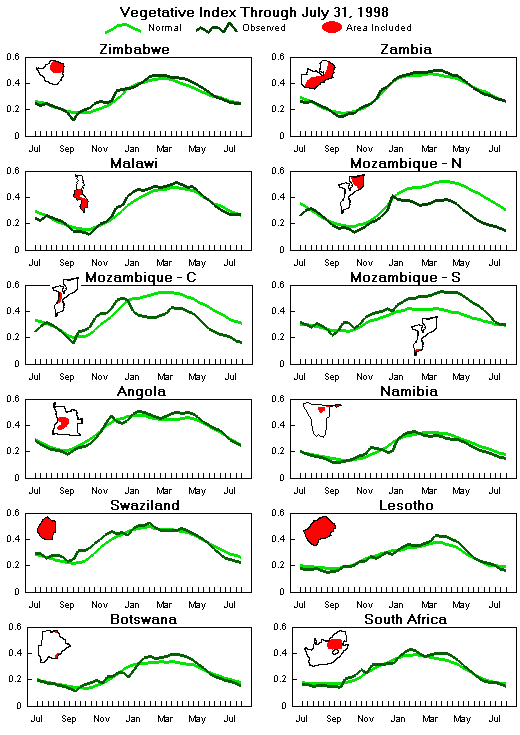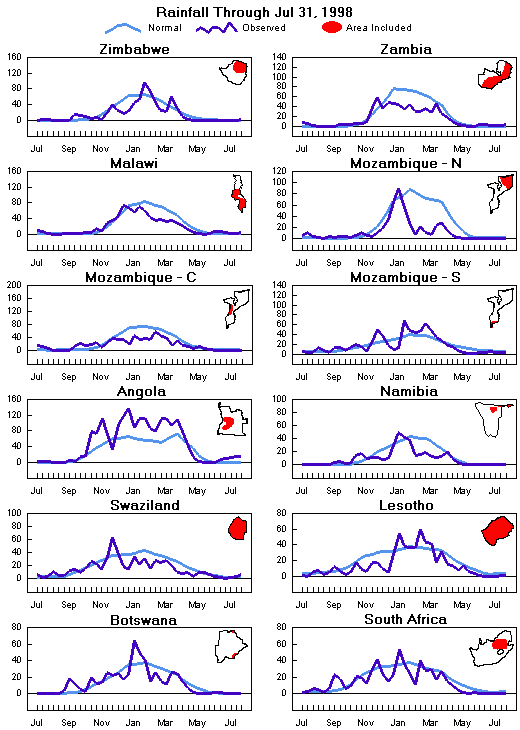Current season
|
Back to historical analysis main page
Seasonal Vegetation Index - 1997/1998

Seasonal Rainfall - 1997/1998
in mm

Current season
|
Back to historical analysis page
Preliminary Monthly Weather Analysis
Southern Africa 1997/1998
From the African Desk, Climate Prediction Center, NOAA
Note: This information should be used with caution.
Weather data based on preliminary reports.
-
July 1998-In southern Africa, seasonably dry conditions prevailed except in South Africa's Cape Province, which reported typical winter rainfall (10-30 mm) and the eastern coast of Madagascar (70-480 mm; 40-140% of normal). Temperatures averaged within 1 to 2 degrees C of normal, except in Zambia (1 to 3 degrees C below normal). >
- July 21-31 1998-As expected, most of southern Africa remained seasonably dry, with light rains of around 10 mm over South Africa's Cape province and Durban. Rainfall intensity eased over Madagascar's eastern coast, where amounts ranged from 20 to 90 mm. Temperatures averaged 3 to 5 degrees C below normal in northern Zambia, but were near normal elsewhere.
-
July 11-20 1998-Most of southern Africa continued to be seasonably dry. For the second consecutive 10-day period, South Africa's Cape Province saw rains ranging from 10 to 35 mm. Rainfall intensity increased significantly over Madagascar's eastern coast, where amounts ranged from 80 to 350 mm (120-400% of normal).
-
July 1-10 1998-Southern Africa remained seasonably dry except for above-normal rains (10-35 mm; 75-275% of normal) in South Africa's Cape Province.
-
June 1998-Seasonably dry conditions were dominant except for locally moderate (50-190 mm; 50-95% of normal) rainfall along the eastern coast of Madagascar. Temperatures averaged 2 to 4 degrees C below normal in Zambia and near normal elsewhere.
-
June 21-30 1998-Southern Africa featured seasonably dry conditions except for light to moderate rains (20-80 mm) over the eastern coast of Madagascar. Precipitation amounts were below normal along the coast of South Africa and Mozambique, but rainfall is typically rather low this time of the year. Temperatures averaged 2 to 4 degrees C above normal over inland South Africa, Zimbabwe, Botswana, and Namibia, while Zambia's temperatures averaged 1 to 3 degrees C below normal.
-
June 11-20 1998-Southern Africa remained seasonably dry except for moderate rainfall (25-120 mm) along the shores of Madagascar. Temperatures averaged 2 to 4 degrees C below normal in Zambia and 3 to 5 degrees C above normal in Namibia.
-
June 1-10 1998-Southern Africa remained seasonably dry except for light to moderate rainfall (15-130 mm) along the eastern coast of Madagascar.
-
May 1998-Southern Africa was mainly dry except for significant rainfall (30-150 mm; 60-250% of normal) over the southeastern and southwestern coast of South Africa and along the eastern coast of Madagascar.
-
Through the end of the month, southern Africa remained seasonably dry except for moderate to heavy rainfall (30-150 mm) along the eastern coast of Madagascar and South Africa. Zambia and Zimbabwe experienced temperatures 1 to 5 degrees C below normal, while South Africa saw readings 1 to 3 degrees C above normal.
-
Through midmonth, seasonably dry conditions prevailed across southern Africa, except for light to moderate rainfall (10-100 mm) reported along the eastern coast of Madagascar and South Africa. The region experienced relatively low temperatures. In much of South Africa, Lesotho, Swaziland, and southern Zimbabwe, temperature readings fell to 1 to 3 degrees C below normal. South Africa recorded its first general freeze of the season. Typically, freezing temperatures occur in the crop areas by the end of April.
-
April 1998-Monthly rainfall was below normal across most of southern Africa, the exception being extreme southern and southeastern South Africa. Outside of South Africa and Mozambique, monthly totals ranged from 0 to 25 mm (0-70% of normal). Rainfall was greater (over 25 mm) in eastern parts of Mozambique and Madagascar and parts of South Africa. Temperatures 2 to 3 degrees C above normal maintained drought conditions over Namibia, where rainfall has been below normal since February.
-
In late April, dry, cool weather prevailed. Rainfall was negligible from southern Democratic Republic of the Congo southward, the exception being moderate rains (10-40 mm) over South Africa's Cape Province and southern Free State. Light rainfall this time of year is typical across southern Africa, as the rainy season ends in most areas by the end of April. An exception was Mozambique, where normal 10-day rainfall is still 10 to 40 mm; no rain fell during this period over most of the country. Over Zimbabwe, the rainy season ended abruptly in mid-March, and little or no rain has since fallen.
-
In early April, rains were drying out, which is typical during this time of year. Rains fell in coastal areas near Pietermaritzburg, South Africa, and Beira and Pemba, Mozambique.
-
March 1998-Early in the month, Zimbabwe was continuing its seasonal drydown with residual rains in the northeast, but by midmonth, good to heavy rains had returned to the northern half of the country and the eastern border. By the end of the month, it was seasonably dry. Through midmonth, Zambia continued to have good to heavy rains over much of the area, but parts of the south and northeast were drier than normal. By the end of the month, the south and east were generally dry, with rains continuing in the north and northwest. Isolated rains also fell in the east, near Chipata. Malawi had some localized patches of rain but was mostly drier than normal throughout the month. Early in the month, Mozambique had good rains in parts of the north and the very far southern tip. Much of the south and center had good to heavy rains at midmonth, with parts of the north and west and the far south remaining drier than normal. By the end of the month, the south was seasonably dry, with light rains continuing in the north. Angola continued to have heavy rains over much of the area throughout the month; only the far south was dry. Namibia had only very light rains early in the month, was quite dry by midmonth, and had scattered showers in the north and west at the end of the month. Northern areas were drier than normal. Botswana had patches of very light rains but was generally dry early in the month. There were good rains in part of the south from midmonth through the end of the month, with continuing light rains in the rest of the south and in the north. The northeast was dry. Early in the month, South Africa had good rains in the southeast, with heavy rains along the coast. By midmonth, only general light to very light rains remained. Good to heavy rains returned late in the month to the southeast coast and central areas. The west had only light rains, and the northeast was quite dry. Lesotho had light rains generally-very light in part of the east and good rains in the west early in the month, but only very light rains by midmonth. Late in the month, good rains returned to many areas. Swaziland had light rains, with a tiny patch of good rains in the northeast early in the month and light to very light rains at midmonth. By month's end, it was drier than normal.
-
February 1998-Southern Zambia continued to be dry-much drier than normal-while the north had seasonably high rainfall levels. Northern Zimbabwe remained rainy, although the rains were tapering off by the end of the month. Rains in this area were near normal levels. Southern areas had some light rains at midmonth but otherwise were quite dry-far below normal levels. Malawi had good rains in the south early in the month and in central and some southern areas later in the month. As a whole, Malawi is still below normal levels. Angola had good to very heavy rains in almost all areas. Only a tiny patch on the far southern coast was dry. Namibia continued drier than normal-only a few patches in the north and east received good rains, although the heavy rains in Angola late in the month did spill over into far north-central Namibia. Mozambique had good rains in the north all month. The west had good rains early in the month, but only light rains thereafter. Southern areas had light rains at midmonth but were otherwise dry. Botswana was dry early in the month and had light rain with good to heavy rains in patches in the south, northwest, and a large part of the northeast. Late in the month generally dry conditions prevailed. Lesotho had good rains in the south early in the month, very heavy rains at midmonth, and good rains in the east late in the month. Swaziland started the month far below normal but had some rains at midmonth-light in the west and good in the east. Late in the month only light rains fell. South Africa started the month quite dry-far below normal levels. By midmonth, good to heavy rains fell in eastern coastal areas, the Free State and the Northwest Province. By the end of the month, the rains had tapered off, with only a few patches receiving good rain: Nelspruit and the coastal area adjoining Lesotho.
-
January 1998-Malawi had rainfall that was somewhat below normal. Zimbabwe, started the month near normal but was far above normal by the end of the month. There were some data problems in Zambia; it may have had good rains, although the images indicate it was dry. Mozambique and South Africa started the month near normal but became quite dry as the month progressed. Swaziland remained below normal. Angola remained far above normal. Lesotho, Namibia, and Botswana started the month far above normal but returned to more normal levels by midmonth.
-
December 1997-Rainfall returned to heavy levels in Angola early in the month and achieved very high levels toward the end of the month. Swaziland, Zambia, Zimbabwe, Botswana, and South Africa dropped to below-normal levels. Namibia spent much of the month below normal, but near the end of the month rose to slightly above-normal levels. Lesotho was far below normal most of the month, but reached normal levels at the end. Throughout the month, Mozambique continued at levels that were slightly below normal, and Malawi continued at levels that were slightly above.
-
November 1997-At the end of November, heavy to very heavy rains fell in much of eastern Angola while the west became drier and the south remained dry. In early November, Angolan rainfall was far above normal levels, but later became somewhat below normal in key agricultural areas. Heavy rains moved into most of Zambia (as is seasonable), with only the far northeast and some areas in the far south remaining dry. Malawi, Mozambique, and Botswana had near-normal rainfall. Swaziland and areas in eastern South Africa had above-normal rains. Lesotho was below normal through all of November, and toward the end of the month, Namibia dropped to levels that were somewhat below normal.
-
October 1997-Heavier-than-normal rains moved across northern and central Angola. There were also some rains in northern and far northwestern Zambia, central Mozambique, north-central Namibia, southern Botswana, and south-coastal South Africa, but all of these were localized storms and did not extend over large areas. Other areas were dry, as is normal for October.
-
September 1997-The rains started early in the month in southern areas, which is unusually early, and moved into northern Angola in late September, which is more usual.
Back to top
|
Current season
|
Back to historical analysis page
|



